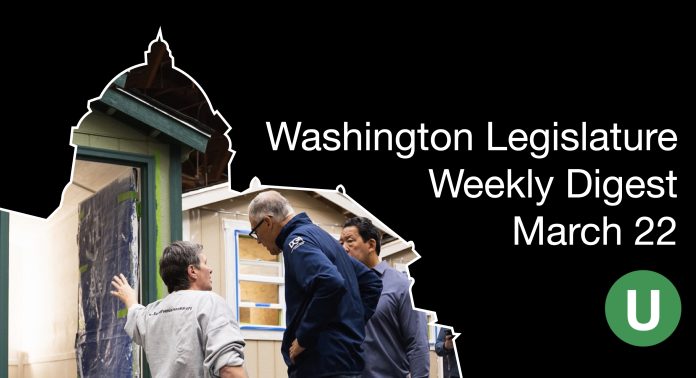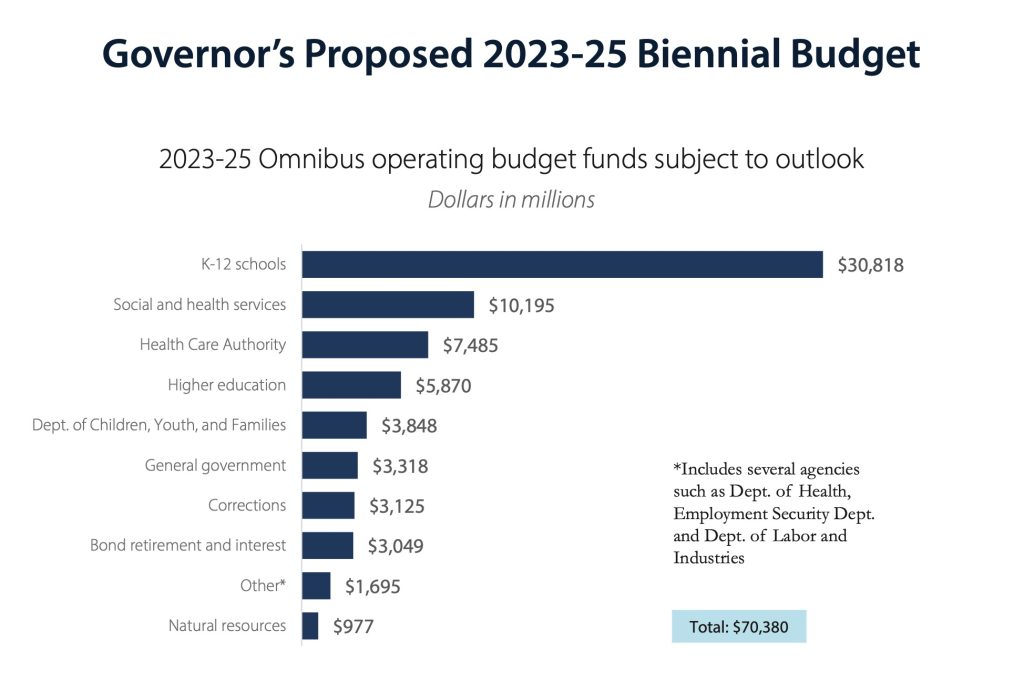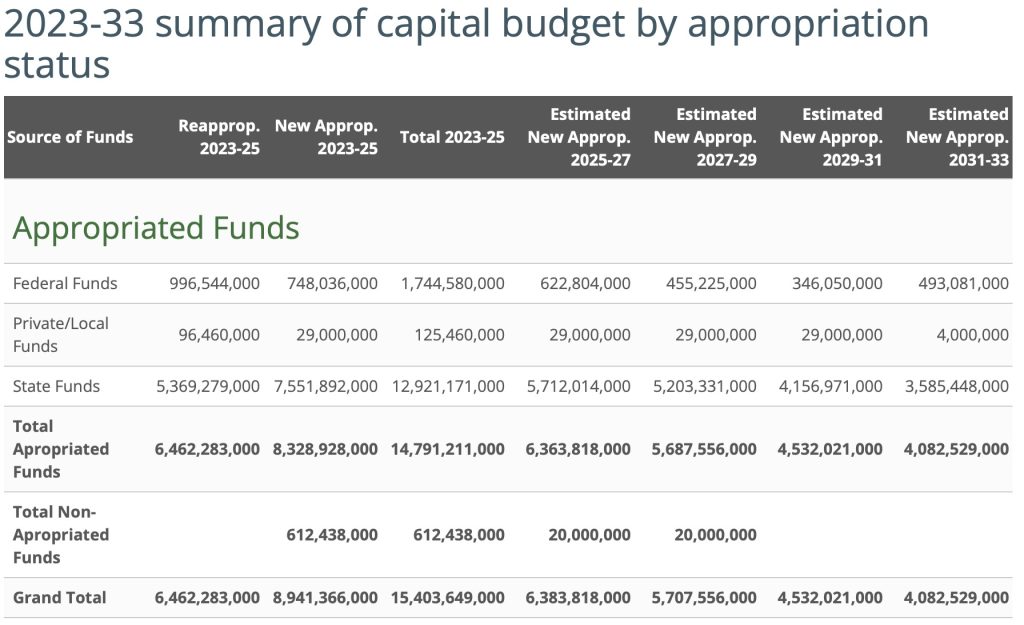
WALeg Wednesday starts eyeing up the looming disagreements as the legislative session moves to finances.
Five of the bills that we have been following continue moving forward, with a few making their committee debuts in after switching chambers. The real action is the addition of the two budget bills at the end. Let’s jump in.
Important Bills At A Glance.
- HB 1110 – Missing Middle Housing
- Next Move – Senate Housing Committee had a public hearing on March 17, followed by an executive session today (March 22).
- More Coverage – Read about the most recent amendments it took to get out of committee and PSRC’s analysis of the number of potential homes the bill would create.
- Notes – As noted previously, the bill passed the House with a striker amendment that made a few changes.
- HB 1181 – GMA Climate Change provisions
- Next Move – Passed out of the Senate Committee on Local Government, Land Use & Tribal Affairs on March 16. Referred to Ways & Means for a public meeting on March 23.
- More Coverage – Please see December’s Meetup with Futurewise and Futurewise’s campaign page.
- SB 5466 – Promoting Transit Oriented Development
- Next Move – The House Committee on Housing held a public meeting on March 16. No further hearings have been scheduled.
- More Coverage – The Urbanist did a big breakdown of the bill from January and also has done a little coverage of transit-oriented development (TOD) in the past. Sightline Institute also has some good info on this TOD bill.
- HB 1245 – Lot Splitting
- Next Move – After a March 14 public hearing, the Senate Committee on Local Government, Land Use and Tribal Affairs will hold an executive session on the bill on March 23.
- More Coverage – See the March 1 WALeg Weekly Focus for more information about the bill.
- Notes – Floor amendment by Rep. Andrew Barkis (R – LD2 Yelm, Eatonville), who is doing some interesting housing work this year, increased resulting lots to minimum 2,000 square feet and effective date to six months after a city’s comp plan update.
- HB 1337 – Easing Barriers for ADUs
- Next Move – After a March 16 public hearing, the Senate Committee on Local Government, Land Use and Tribal Affairs will hold an executive session on the bill on March 23.
- More Coverage – See the March 1 WALeg Weekly Focus for more information about the bill.
- Notes – Striker amendment inserted language about Urban Growth Area compliance and coordination by the Department of Commerce.
- SB 5200 – The Capital Budget
- Companion Bill – HB 1147
- Next Move – Mar 20 – Public hearing in the Senate Committee on Ways & Means.
- Mar 22 – Scheduled for executive session in the Senate Committee on Ways & Means.
- More Coverage – Here are the details of the Proposed Substitute Senate Bill (PSSB) 5200. See below for more information about the budget process.
- SB 5187 – The Operating Budget
- Companion Bill – HB 1140
- Next Move – Mar 24 – Scheduled for public hearing in the Senate Committee on Ways & Means at 2:00pm.
- More Coverage – See below for more information about the budget process.
Weekly Focus: A First Look At Washington’s Budget
Part of the reason Washington has legislative sessions that are long (105 days) on odd years and short (60 days) on even years is that the state writes a biennial — two year — budget. This is an odd year and a long session, so we are getting ready for budget season.
The state’s budget has two parts: an operating budget and a capital budget. An operating budget is the money that goes towards the salaries and expenses of running state government, plus all the education, public safety, and health department support the state gives to local jurisdictions. Estimated at $70 billion for the coming biennium, the operating budget is funded through taxes, fees, and federal grants. The capital budget builds stuff, and is mostly funded through debt in the form of bonds.
In December, Governor Jay Inslee unveiled his proposal for the biennial budget. The lion’s share goes to K-12 schools, followed at some distance by healthcare and higher ed. This is an increase of $8 billion over the 2021-2023 budget which was thrown for a complete loop by the pandemic. The increased expenditures were justified by emphasizing the fast recovery from the pandemic recession. A “public health crisis with serious economic consequences — as opposed to the more typical economic crisis with public health consequences,” in the executive office’s words.

The capital budget is a little more complex since the debt that is being financed runs over multiple budget cycles. The state expects to continue paying – reappropriating – about $5 billion in capital projects that were already approved. The governor proposes $8.3 billion on top of that, a significant leap. Half of the new capital budget, some $4 billion, is intended to build 5,300 new housing units this biennium, with 19,000 more over the following six years. “Go big so people can go home,” as the governor recently told The Urbanist Podcast about the plan. The jump exceeds the state’s debt limit, so it will require a treferendum.

However, the actual work of pounding out the numbers remains a prerogative of the legislature. We got a glimpse of where the tension will be this year as the Senate Ways and Means committee rolled out its first swing at the capital budget. Proposing broadly similar initiatives on housing, the Senate committee brought the overall figure in about a billion dollars lower. Without exceeding the current debt limit, the committee suggested the figure would preserve the state’s AAA bond rating and a referendum would be unnecessary.
The governor, in a press release, was less than enthused: “It’s less than what we approved last biennium. In the middle of a housing crisis, less is unacceptable.”
This dustup outlines the concerns at the state for this budget cycle. Legislators are looking towards managing fiscal difficulties in the near future. “This is a strong budget that steps up to the scale of the challenges facing our state, and does so in a fiscally responsible way that we can sustain into the future,” said Sen. Mark Mullet (D-Issaquah), Vice Chair of the Senate Ways & Means Committee when releasing the capital budget.
Those concerns are valid given the Office of Financial Management’s most recent projection of a $483 million decrease in forecasted state revenue. Progress on raising new progressive revenue, such as via a wealth tax, could allay those concerns, but hardly seems a done deal — in part because folks like Sen. Mullet have opposed such measures.
Ray Dubicki is a stay-at-home dad and parent-on-call for taking care of general school and neighborhood tasks around Ballard. This lets him see how urbanism works (or doesn’t) during the hours most people are locked in their office. He is an attorney and urbanist by training, with soup-to-nuts planning experience from code enforcement to university development to writing zoning ordinances. He enjoys using PowerPoint, but only because it’s no longer a weekly obligation.

